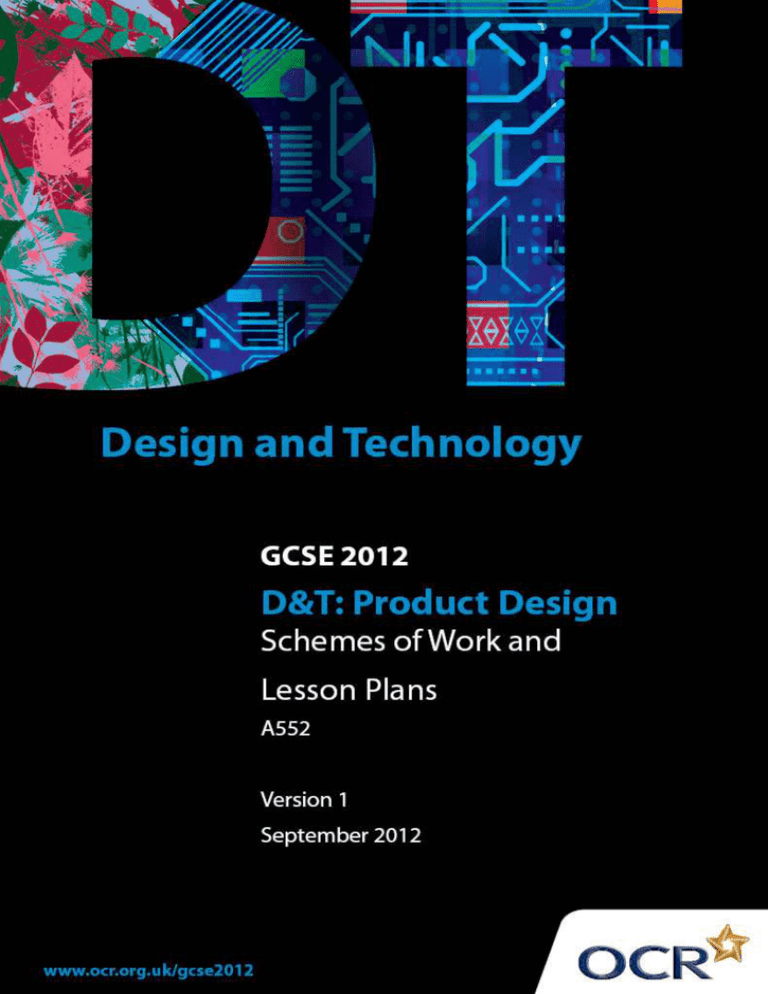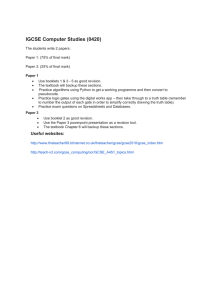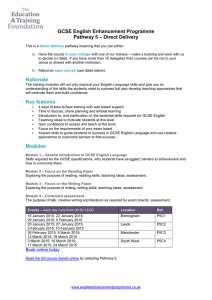Unit A552 - Design and making innovation challenge - Sample scheme of work and lesson plan booklet (DOC, 471KB)
advertisement

© OCR 2008 Contents Contents 2 Introduction 3 OCR GCSE Design & Technology Product Design: Sample Scheme of Work 5 OCR GCSE Design & Technology Product Design: Sample Lesson Plan 2 of 15 13 GCSE Design & Technology: Product Design Introduction Background OCR has produced a summary brochure, which summarises the changes to Design & Technology. This can be found at www.ocr.org.uk, along with the 2012 specification. In order to help you plan effectively for the implementation of the new specification we have produced these schemes of work and sample lesson plans for Design & Technology. These support materials are designed for guidance only and play a secondary role to the specification. Our Ethos OCR involves teachers in the development of new support materials to capture current teaching practices tailored to our new specifications. These support materials are designed to inspire teachers and facilitate different ideas and teaching practices. Each scheme of work and set of sample lesson plans are provided in Word format to be used as a foundation to build upon and amend the content to suit your teaching style and students’ needs. The scheme of work and sample lesson plans provide examples of how to deliver these units and suggested teaching hours which could be applicable to your teaching. The specification is the document on which assessment is based and specifies what content and skills need to be covered in delivering the course. At all times, therefore, this support material booklet should be read in conjunction with the specification. Any clarification should be found in the specification. GCSE Design & Technology: Product Design 3 of 15 A Guided Tour through the Scheme of Work = Innovative Teaching Idea This icon is used to highlight exceptionally innovative ideas. = ICT Opportunity This icon is used to illustrate when an activity could be taught using ICT facilities. 4 of 15 GCSE Design & Technology: Product Design Sample GCSE Scheme of Work OCR GCSE D&T PRODUCT DESIGN UNIT A552: DESIGN AND MAKING INNOVATION CHALLENGE SUGGESTED TEACHING TIME 25-30 HOURS TOPIC OUTLINE Use collections of existing products as a stimulus for innovative design. TOPIC SUGGESTED TEACHING AND HOMEWORK ACTIVITIES SUGGESTED RESOURCES POINTS TO NOTE Students should be able to handle the items Key words will need explaining Possible items that could be made include; a mobile first aid system/device, a healthy, refreshing drink and snack, a drinks/ snacks transportation system, a portable time keeping device, an accurate easy to operate measuring system, safe storage for javelins between events, etc Students will need to produce and keep a paper-based portfolio of their work Think with an ‘open’ mind about a design situation. On a school sports day, not all students participate in the sporting events. The opportunities for these students still to be involved and support the event and the SCHOOL SPORTS DAY Organise the students into small groups, giving each group an item from the collection to analyse and discuss function, form, aesthetics, durability and target users Each group to make a short presentation about their item (alternatively this could be done as a whole class discussion) For homework the students can write about a pair of trainers they own Set the scene by introducing the Design Situation Look at the video/photographs where available Allow the students time to look at/handle the resources = Innovative teaching idea GCSE Design & Technology: Product Design Handling collection consisting of items associated with sports day and other items that may be of interest A range of solutions for transporting drinks and snacks can be obtained from fast food outlets A worksheet could be devised to support this activity A starter activity could be devised to make the students aware that they need to be thinking ‘outside the box’ away from their ‘comfort zone’ Photographs/video from school sports day Handling collection = ICT opportunity 5 of 15 Sample GCSE Scheme of Work OCR GCSE D&T PRODUCT DESIGN UNIT A552: DESIGN AND MAKING INNOVATION CHALLENGE SUGGESTED TEACHING TIME 25-30 HOURS TOPIC OUTLINE arrangements for the event are numerous. Respond in ways which might appear at first ‘unrealistic’ yet, after consideration, provide a unique, valuable contribution to designing = Innovative teaching idea 6 of 15 TOPIC SCHOOL SPORTS DAY SUGGESTED TEACHING AND HOMEWORK ACTIVITIES SUGGESTED RESOURCES POINTS TO NOTE Discuss with the students what could be designed. Use a mind map to record initial thoughts Using notes and sketches, students produce their own ideas of what could be made Explain/discuss the exemplar ideas Working in small groups students pool their ideas and identify examples that they consider predictable, look like they are ‘wacky’ or creative and those ideas that are surprising and different A set of exemplar ideas to help explain the difference between, predictable, wacky and challenging (surprising) In the actual exam supplementary information will be included which the candidates need to take into account A collection of design briefs showing examples, which are too narrow, and ones that allow scope for creativity Briefs should not be too prescriptive but should be clear, precise and open enough to allow scope for creativity Writing frames Collection of small familiar products (pencil sharpeners, calculators mp3 players, pencil cases etc) When discussing user groups be specific rather than general When writing a design specification for this unit it is preferable, for the purposes of clarity, to do so in bullet point form Class discussion and teacher questions to ensure understanding For homework the students are to identify their three best ideas, explaining why they have chosen them Explain what a design brief is (using the examples as appropriate) Exemplar design specifications to show the difference between those that are generic and could be applied to anything and those = ICT opportunity GCSE Design & Technology: Product Design Sample GCSE Scheme of Work OCR GCSE D&T PRODUCT DESIGN UNIT A552: DESIGN AND MAKING INNOVATION CHALLENGE SUGGESTED TEACHING TIME 25-30 HOURS TOPIC OUTLINE Record thinking, innovation TOPIC SCHOOL SPORTS DAY SUGGESTED TEACHING AND HOMEWORK ACTIVITIES Discuss/brainstorm what designers mean by ‘user groups’. Record the responses on the board Students write up the brief they consider to have the potential for creative design, explain who the users are and what their specific needs will be, and describe the context in which the design will be used Explain what a specification is The students select items from the collection and write up a specification using bullet points. This could be an individual or paired activity Students write a design specification relating to their design brief, user needs and context in which the design will be used Discuss/brainstorm ways in which ideas can = Innovative teaching idea GCSE Design & Technology: Product Design SUGGESTED RESOURCES POINTS TO NOTE that clearly identify the key features of the product to be designed Worksheets to allow students to re-visit and At KS3 students will have learnt how to = ICT opportunity 7 of 15 Sample GCSE Scheme of Work OCR GCSE D&T PRODUCT DESIGN UNIT A552: DESIGN AND MAKING INNOVATION CHALLENGE SUGGESTED TEACHING TIME 25-30 HOURS TOPIC OUTLINE TOPIC SCHOOL SPORTS DAY SUGGESTED TEACHING AND HOMEWORK ACTIVITIES SUGGESTED RESOURCES be presented and enhanced and flair practice presentation techniques Practice the techniques through a series of closed focussed exercises to build up individual skill levels. This should take place in the classroom and also be set for homework Demonstrate the ability to focus thoughts and be decisive within a set, limited time frame Start designing. Using the 4x4 method to develop ideas Stopwatch or timer (when using the 4x4 method) Identify problems, the best idea and the most unusual idea Worksheet for recording responses Reflect and record ideas as they develop Students add notes to their designs, make simple paper or card models and use Digital cameras = Innovative teaching idea 8 of 15 POINTS TO NOTE present their ideas in 2D and 3D using a range of recognised techniques (isometric, oblique etc) and how to render, use thick and thin line, colour, overlays etc Page 5 of the candidate workbook for this unit (Traffic Light Zone) could be adapted into a suitable worksheet for students to record their responses As the work progresses it is essential that students use the presentation and = ICT opportunity GCSE Design & Technology: Product Design Sample GCSE Scheme of Work OCR GCSE D&T PRODUCT DESIGN UNIT A552: DESIGN AND MAKING INNOVATION CHALLENGE SUGGESTED TEACHING TIME 25-30 HOURS TOPIC OUTLINE TOPIC SCHOOL SPORTS DAY SUGGESTED TEACHING AND HOMEWORK ACTIVITIES SUGGESTED RESOURCES POINTS TO NOTE photographs to show progress If necessary students should be shown how to capture and process images to support their work Seek opinions of others and react accordingly Present to a group and acknowledge feedback Working in groups of 4 each student presents their idea to the others carefully describing how their design works Record action points to improve or modify their idea Update designs based on the feedback Students finalise their designs giving reasons for why a design is worthy of further development or why it is rejected Identify good design ideas worthy of further development and reject those of less value = Innovative teaching idea GCSE Design & Technology: Product Design enhancement techniques previously taught Exemplar material produced by other students This activity can be found in the Student Workbook under ‘Reflect and Record’ To access the higher marks in the exam students will need to be able to provide detailed analysis along with justification for the rejection of ideas in favour of ones = ICT opportunity 9 of 15 Sample GCSE Scheme of Work OCR GCSE D&T PRODUCT DESIGN UNIT A552: DESIGN AND MAKING INNOVATION CHALLENGE SUGGESTED TEACHING TIME 25-30 HOURS TOPIC OUTLINE TOPIC SCHOOL SPORTS DAY SUGGESTED TEACHING AND HOMEWORK ACTIVITIES SUGGESTED RESOURCES POINTS TO NOTE worthy of further development Use modelling materials adeptly. Plan the use of materials and equipment = Innovative teaching idea 10 of 15 Show the students how to produce prototypes, models and mock ups using a range of materials. This could include making part of a product e.g. an unusual hinge mechanism Discuss health and Safety The students should be given time to practice these techniques Students produce a list of materials/ingredients they need to make the prototype of their design Students write up how they are going to join the materials Brainstorm how CAM can be used to produce the design in quantity. Record the responses on the board Suitable materials can include foam, foam board, card, balsa, modelling clay, mechanism kits, polymorph, polypropylene, etc An online health and safety quiz could be devised A table of appropriate modelling materials needs to be available Students need to also use technical language Construction kits and scrap materials are allowed Where the work is taking place in a Food area then appropriate ingredients need to be available Materials such as pine, MDF, plywood and acrylic sheet are not appropriate. (Principal Examiner January 2008) = ICT opportunity GCSE Design & Technology: Product Design Sample GCSE Scheme of Work OCR GCSE D&T PRODUCT DESIGN UNIT A552: DESIGN AND MAKING INNOVATION CHALLENGE SUGGESTED TEACHING TIME 25-30 HOURS TOPIC OUTLINE Make a prototype of their design proposal. Record progress using sketches and photographs Sum up progress and identify possible further design development. TOPIC SCHOOL SPORTS DAY SUGGESTED TEACHING AND HOMEWORK ACTIVITIES SUGGESTED RESOURCES POINTS TO NOTE Students make their own prototypes from the modelling materials available The time allowed for this should be reflected in the planning The portfolio should be updated with photographs and additional notes and sketches Availability of digital cameras so that students can record evidence of their own progress Access to a colour printer The objective is to produce ‘prototype products’ not final outcomes Technician support if available Capture images of good practice to show to the whole class Bluetooth phone with camera, computer, projector and screen Students collate all their work Evaluate the work completed Working in groups of 4 students look at each other’s portfolio. On a worksheet they record one thing they like about the design, something they think could be improved and a question about the design. At the end of Worksheet (for each portfolio) to record peer comments and questions Page 11 of the Candidate Booklet can be adapted into a suitable worksheet for the evaluation To access the higher marks in the exam students will need to show evidence of detailed analysis throughout the portfolio = Innovative teaching idea GCSE Design & Technology: Product Design = ICT opportunity 11 of 15 Sample GCSE Scheme of Work OCR GCSE D&T PRODUCT DESIGN UNIT A552: DESIGN AND MAKING INNOVATION CHALLENGE SUGGESTED TEACHING TIME 25-30 HOURS TOPIC OUTLINE TOPIC SCHOOL SPORTS DAY SUGGESTED TEACHING AND HOMEWORK ACTIVITIES SUGGESTED RESOURCES POINTS TO NOTE the exercise this will provide individuals with feedback to help with their evaluation Reflection = Innovative teaching idea 12 of 15 Students evaluate their own design on a suitable worksheet Review of their ideas Page 2 of the Candidate Booklet (Time to Reflect) 30 minutes should be allowed if this is done under exam conditions = ICT opportunity GCSE Design & Technology: Product Design Sample GCSE Lesson Plan OCR GCSE D&T Product Design Unit A552: Design and making innovation challenge OCR recognises that the teaching of this qualification above will vary greatly from school to school and from teacher to teacher. With that in mind this lesson plan is offered as a possible approach but will be subject to modifications by the individual teacher. Lesson length is assumed to be one hour. Learning Objectives for the Lesson Objective 1 Students to understand the difference between a good specification, one that is too general and one that is vague. Objective 2 Students to compare different styles of presenting a specification Objective 3 Students to be able to write a design specification Recap of Previous Experience and Prior Knowledge Students have been working on the Sports Day theme. By now they will have recorded in their portfolio initial thoughts, written a design brief, identified the users and where the intended design will be used. The next step is to write the design specification. Content Time Content 10 minutes Starter Activity: 10 minutes Ask the students to select an item from a handling collection consisting of familiar products. E.g. pencil sharpeners, calculators’ mp3 players, pencil cases etc. Give each student a card with a specification written on it. Some cards will have a specification with all the key points listed, others will be vague and others will be generic (i.e. applicable to any product). They then find the person who has the product that best fits the specification on their card. List the products on the board then ask the students to comment on whether the specification given was, too general, vague or specific to the product. Summarise this by explaining what a specification is and why designers use them. Using ICT or more traditional methods introduce the students to exemplar specifications written using paragraphs and bullet points. ICT The examples used should ideally be based on familiar products. E.g. a pair of trainers or mobile phone. GCSE Design & Technology: Product Design 13 of 15 Sample GCSE Lesson Plan The material chosen should make it clear to the students that using bullet points provides much greater clarity. GCSE Design & Technology: Product Design 14 of 15 Sample GCSE Lesson Plan 10 minutes 20 minutes Students select a different item from the handling collection. They write down what they think the original designer would have put in the design specification for that product. Working in pairs each student comments upon one another’s specification as to whether it is good, general or vague. Students work independently on their own product specification. Their initial attempt should be shared with a partner, modifying it based on feedback given. Consolidation Time Content 10 minutes Class discussion about the written task supplemented with teacher questions to establish understanding. Homework: Students write up the amended specification in their portfolio. GCSE Design & Technology: Product Design 15 of 15






